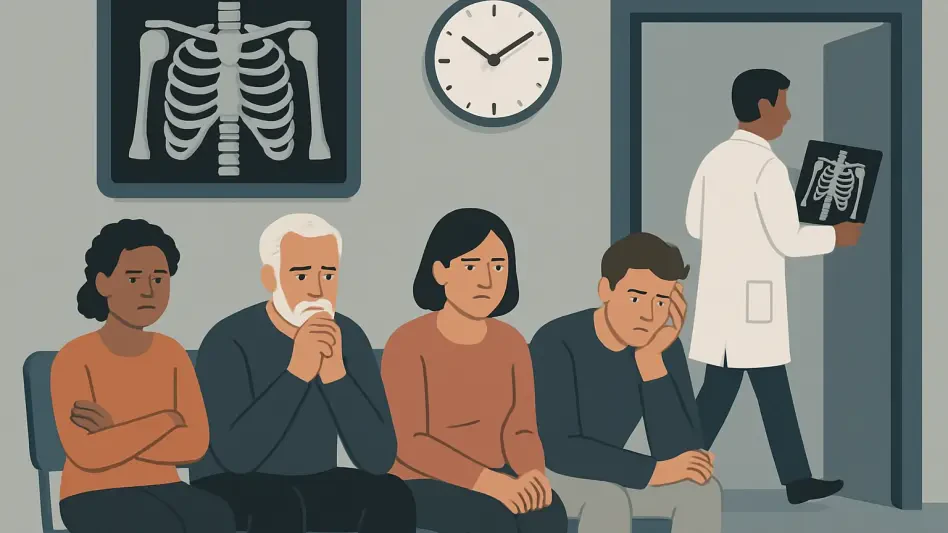In a startling case that has sent ripples through the healthcare community, Doctors Imaging Group (DIG), a Florida-based X-ray provider, suffered a massive data breach that compromised the personal and medical information of over 170,000 patients. The incident, which took place between November 5 and November 11, 2024, was not disclosed to those affected until nearly a year later, raising serious questions about the timeliness and adequacy of the clinic’s response. This delay left countless individuals unaware of the potential risks to their financial and personal security, exposing them to threats like identity theft and fraud. As cybercriminals continue to target sensitive healthcare data, this breach serves as a grim reminder of the vulnerabilities within the industry. The following discussion delves into the specifics of the delayed notification, the clinic’s response, the broader context of healthcare cybersecurity, and the severe implications for victims, shedding light on a critical issue that demands urgent attention.
Unpacking the Year-Long Silence
The timeline of the data breach at DIG has come under intense scrutiny due to the extended delay in notifying affected patients. Occurring in early November 2024, the breach remained unconfirmed in its full scope until August 29, 2025, following a prolonged forensic investigation. This nearly year-long gap meant that individuals had no knowledge of the compromise, preventing them from taking essential steps such as monitoring their accounts or freezing their credit to mitigate risks. Such a delay is particularly alarming given the sensitive nature of the exposed information, which could be exploited in numerous harmful ways. Critics have pointed out that timely disclosure is a cornerstone of data breach protocols, as it empowers victims to act swiftly. The extended silence from DIG not only heightened the potential damage but also eroded trust in an organization tasked with safeguarding deeply personal information, prompting questions about accountability and transparency in crisis management.
Beyond the initial delay, the impact of this slow response cannot be overstated when considering the broader implications for patient safety. Cybersecurity experts argue that every day a breach goes unreported increases the likelihood of fraud, as stolen data can be sold or misused almost immediately on illicit markets. For the 171,862 individuals affected by this incident, the lack of prompt communication translated into months of vulnerability, with no opportunity to protect themselves against potential threats. This situation highlights a critical flaw in the notification process at DIG, where the focus appeared to be on internal assessments rather than the urgent needs of those impacted. The healthcare sector, already grappling with frequent cyberattacks, must prioritize rapid disclosure to minimize harm. This case serves as a stark example of how delays can exacerbate the consequences of a breach, leaving patients to bear the burden of risks that could have been mitigated with faster action.
Evaluating the Clinic’s Insufficient Measures
When it comes to DIG’s handling of the aftermath, the response has been widely criticized as falling short of industry standards. While the company stated that it moved quickly to investigate the breach and strengthen its network security, it notably failed to provide free credit monitoring or identity protection services to those affected. Such offerings are often considered a baseline gesture of support in the wake of data breaches, helping victims detect and address fraudulent activity. Instead, DIG limited its guidance to advising patients to monitor their financial statements and consider placing fraud alerts or credit freezes on their accounts. This minimal approach has been seen as a significant oversight, leaving many individuals feeling unsupported by a provider they entrusted with their most confidential data. The absence of proactive assistance raises concerns about corporate responsibility in safeguarding patient welfare after a security failure.
Moreover, the lack of robust support from DIG underscores a troubling gap in how some healthcare providers address the human impact of data breaches. Offering actionable resources, such as complimentary identity protection, can significantly reduce the stress and potential harm faced by victims navigating the fallout. Without such measures, affected individuals are left to manage complex and time-consuming tasks on their own, from scrutinizing bank transactions to disputing unauthorized charges. This hands-off stance by DIG not only amplifies the burden on patients but also diminishes confidence in the organization’s commitment to their well-being. As data breaches become more common, healthcare entities must adopt comprehensive response strategies that prioritize victim support over mere procedural compliance. The criticism directed at DIG reflects a broader expectation for companies to take greater accountability, ensuring that those impacted are not left to fend for themselves in the face of significant risks.
Healthcare Sector’s Persistent Vulnerabilities
Looking at the bigger picture, the breach at DIG is symptomatic of a much larger challenge facing the healthcare industry. Cybercriminals frequently target medical providers due to the immense value of personal and health-related data on underground markets, often fetching higher prices than other types of stolen information. Compounding this issue is the prevalence of outdated IT infrastructure among many healthcare organizations, which struggles to withstand sophisticated attacks. With millions of patients impacted by similar incidents across the U.S. in recent times, the sector’s systemic weaknesses are glaringly evident. Clinics and hospitals, including smaller providers like DIG, often lack the resources or expertise to implement cutting-edge defenses, making them easy prey for hackers. This persistent vulnerability calls for a reevaluation of how the industry approaches cybersecurity, with a focus on modernization and resilience against evolving threats.
Additionally, the critical nature of healthcare operations exacerbates the challenge of securing data, as any disruption can have life-altering consequences. Providers must balance the need for uninterrupted service with the imperative to protect sensitive information, a task made difficult by limited budgets and competing priorities. The DIG incident illustrates how even a single breach can affect a vast number of individuals, amplifying the urgency for sector-wide improvements. Government regulations and industry standards must evolve to enforce stricter cybersecurity protocols, while providers need access to funding and training to upgrade their systems. Without these changes, healthcare organizations will remain prime targets, and patients will continue to face the fallout of inadequate protections. The recurring pattern of attacks signals a need for collective action to fortify defenses, ensuring that patient trust is not repeatedly undermined by preventable security lapses.
Long-Term Risks of Exposed Medical Data
The consequences of the DIG breach extend far beyond the initial compromise, as the type of data stolen poses severe, enduring risks to victims. Hackers accessed highly sensitive details, including full names, addresses, medical records, and Social Security Numbers, which can be bundled into comprehensive profiles known as “fullz” and sold on the dark web. These profiles enable a range of criminal activities, from medical identity theft—where fraudulent insurance claims or services are obtained under a victim’s name—to financial fraud like opening unauthorized credit lines. The static nature of medical information, unlike a password that can be reset, means that once exposed, the threat lingers indefinitely. This reality places an immense burden on affected individuals, who must remain vigilant for years to come, constantly guarding against exploitation in ways that are both time-intensive and emotionally draining.
Furthermore, the potential misuse of stolen health data opens up even darker possibilities, such as targeted phishing scams or extortion schemes. Cybercriminals can leverage personal medical details to craft convincing fraudulent communications or threaten to expose sensitive information unless demands are met. These tactics exploit not just financial vulnerabilities but also the deep personal impact of having private health conditions weaponized against victims. The long-term ramifications of such breaches highlight why rapid notification and robust protective measures are non-negotiable. Patients affected by the DIG incident face a heightened risk of these abuses, with little recourse to undo the damage. This underscores the critical need for healthcare providers to prevent breaches in the first place and to respond decisively when they occur, ensuring that the devastating ripple effects of stolen data are minimized through proactive and comprehensive safeguards.








